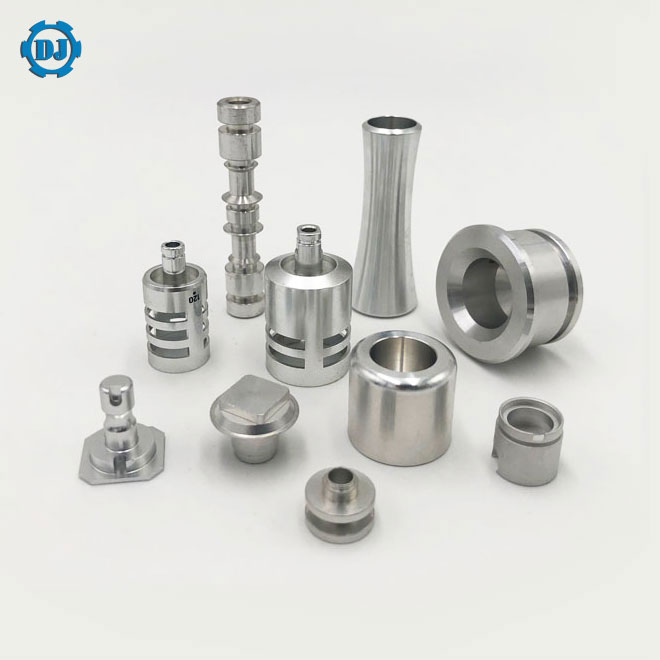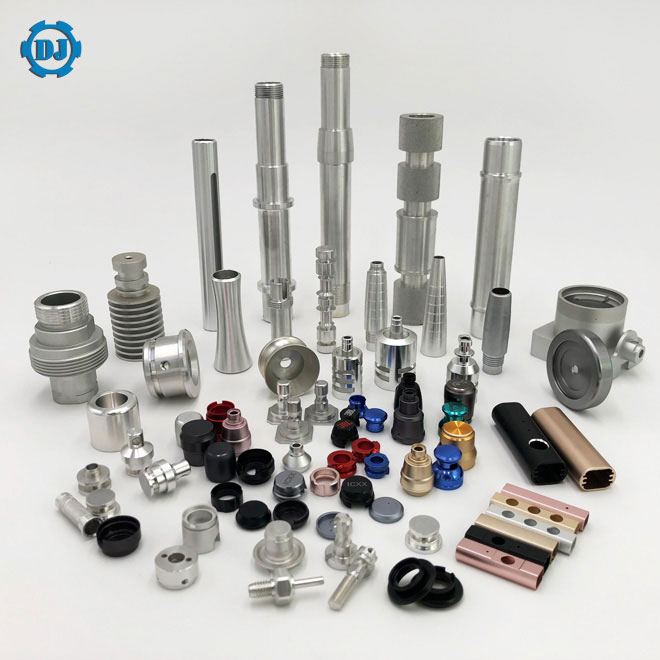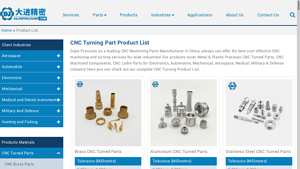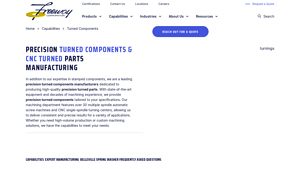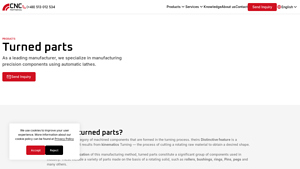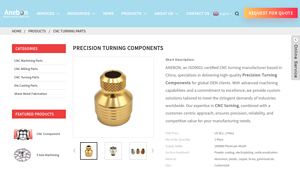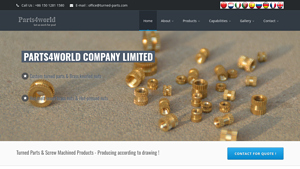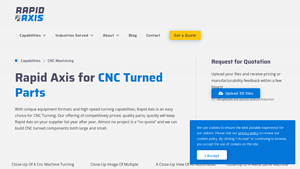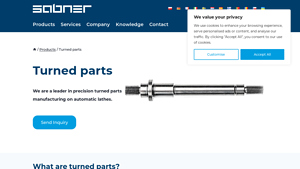Turning Components Guide: Type, Cost, Top List…
Introduction: Navigating the Global Market for turning components
In today’s competitive landscape, sourcing high-quality turning components can be a daunting task for international B2B buyers. With a myriad of suppliers across diverse regions, such as Africa, South America, the Middle East, and Europe, the challenge lies in identifying reliable partners who can deliver precision-engineered components that meet stringent specifications. This comprehensive guide serves as an essential resource for navigating the global market for turning components, providing insights into various types of components, their applications, and best practices for supplier vetting.
Throughout this guide, we will explore the intricacies of CNC turning, detailing the wide range of parts that can be produced—ranging from shafts and bushings to intricate medical devices. Additionally, we will cover critical considerations such as cost factors, material choices, and quality standards that can significantly impact purchasing decisions. By equipping buyers with actionable information and strategic insights, this guide empowers B2B decision-makers to make informed choices that enhance their operational efficiency and product quality.
As you delve into the sections that follow, you will gain a deeper understanding of how to identify the right suppliers, evaluate their capabilities, and ultimately secure turning components that align with your business objectives. Whether you are in the aerospace, automotive, or medical industry, this guide is designed to help you navigate the complexities of sourcing turning components with confidence.
Understanding turning components Types and Variations
| Type Name | Key Distinguishing Features | Primary B2B Applications | Brief Pros & Cons for Buyers |
|---|---|---|---|
| Bushings | Cylindrical shape, smooth surfaces, reduces friction | Automotive, Industrial Machinery | Pros: Essential for alignment; Cons: Limited to specific applications. |
| Shafts | Long, cylindrical, often with precise diameters | Aerospace, Automotive, Energy | Pros: Vital for power transmission; Cons: Requires high precision. |
| Flanges | Circular with bolt holes for secure connections | Piping Systems, HVAC, Oil & Gas | Pros: Enables easy assembly; Cons: Must match specific standards. |
| Connectors | Designed for electrical connections, various shapes | Electronics, Telecommunications | Pros: Ensures reliable connectivity; Cons: May require custom designs. |
| Fasteners | Includes screws, bolts, and nuts with threading | Construction, Automotive, Aerospace | Pros: Widely used; Cons: Requires careful specification of sizes. |
What Are the Key Characteristics of Bushings in B2B Applications?
Bushings are cylindrical components designed to minimize friction between moving parts while maintaining alignment in mechanical assemblies. Their uniform dimensions and smooth finishes are critical for optimal performance, making them essential in industries like automotive and industrial machinery. When sourcing bushings, buyers should consider material selection, as it impacts durability and friction properties, alongside tolerance requirements to ensure precise fitting.
How Do Shafts Function in Various Industries?
Shafts are long, cylindrical components that play a crucial role in transmitting torque and rotational motion in machinery. They are commonly used in aerospace, automotive, and energy sectors. B2B buyers must focus on the shaft’s material and diameter specifications, as these factors directly influence performance and durability. Precision machining is vital to ensure that shafts meet stringent industry standards and can withstand operational stresses.
Why Are Flanges Important for Industrial Connections?
Flanges are circular components with bolt holes that facilitate connections between pipes, valves, and other equipment in various systems. Their precise circular shapes and accurate bolt hole positioning are essential for secure and leak-proof connections, particularly in piping systems and HVAC applications. Buyers should prioritize the compatibility of flanges with existing systems and consider the material used, as it affects the flange’s strength and corrosion resistance.
What Role Do Connectors Play in Electronics?
Connectors are critical components designed for establishing electrical connections across various applications, including electronics and telecommunications. They come in multiple shapes and sizes, tailored to specific uses. B2B buyers should assess the connector’s electrical specifications, such as voltage and current ratings, and consider the need for custom designs to meet unique application requirements, ensuring reliability and performance.
How Do Fasteners Contribute to Structural Integrity?
Fasteners, including screws, bolts, and nuts, are essential for joining components in construction, automotive, and aerospace industries. Their threading and sizing must be precise to ensure secure connections. When purchasing fasteners, buyers should carefully evaluate the material and coating options to prevent corrosion and ensure longevity. Additionally, understanding the specific application requirements can help in selecting the right fasteners for optimal performance.
Key Industrial Applications of turning components
| Industry/Sector | Specific Application of Turning Components | Value/Benefit for the Business | Key Sourcing Considerations for this Application |
|---|---|---|---|
| Aerospace | Production of shafts and hydraulic fittings | High precision and reliability in critical systems | Material certifications, precision tolerances, and lead times |
| Automotive | Manufacturing of camshafts and drive shafts | Enhanced performance and durability of vehicles | Compliance with automotive standards and testing, surface treatments |
| Medical | Creation of surgical instruments and implants | Safety and precision in life-critical applications | Biocompatibility, strict tolerances, and regulatory compliance |
| Oil & Gas | Fabrication of valves and couplings | Improved operational efficiency and safety | Material selection for corrosion resistance, certifications |
| Electronics | Development of connectors and housings | Reliable performance in electronic devices | Customization options, lead times, and quality control measures |
How Are Turning Components Utilized in the Aerospace Industry?
Turning components play a vital role in the aerospace sector, particularly in the production of shafts and hydraulic fittings. These components must meet stringent specifications to ensure the safety and performance of aircraft systems. By utilizing CNC turning, manufacturers can achieve the necessary precision and repeatability required for high-stakes applications. Buyers in this sector must consider material certifications, precise tolerances, and lead times, as delays can impact aircraft safety and operational efficiency.
What Are the Key Applications of Turning Components in the Automotive Industry?
In the automotive industry, turning components are crucial for manufacturing camshafts and drive shafts, which are essential for vehicle performance. These components require high durability and precision to withstand the stresses of operation. The use of CNC turning allows for the production of complex geometries that meet the rigorous standards of the automotive market. Buyers should focus on suppliers that comply with automotive quality standards, offer testing capabilities, and provide surface treatment options to enhance component longevity.
How Do Turning Components Benefit the Medical Sector?
Turning components are indispensable in the medical field, particularly for creating surgical instruments and implants. Precision is paramount, as any deviation can lead to severe consequences. CNC turning enables the production of intricate designs with high tolerances, essential for ensuring patient safety. International buyers must prioritize suppliers that can guarantee biocompatibility, adhere to strict regulatory requirements, and provide documentation for quality assurance.
Why Are Turning Components Important for the Oil & Gas Industry?
In the oil and gas sector, turning components are extensively used to manufacture valves and couplings that facilitate the safe and efficient flow of resources. These components often operate in harsh environments and must be designed to resist corrosion and wear. Effective sourcing requires an understanding of material properties and certifications that ensure reliability under extreme conditions. Buyers should also consider the supplier’s ability to deliver on time, as delays can lead to significant operational disruptions.
How Are Turning Components Used in the Electronics Industry?
Turning components are essential for the development of connectors and housings in the electronics industry, where reliability and performance are critical. These components must be manufactured with precision to ensure seamless integration into electronic devices. Buyers should seek suppliers that offer customization options, rigorous quality control measures, and efficient lead times to meet the fast-paced demands of the electronics market.
3 Common User Pain Points for ‘turning components’ & Their Solutions
Scenario 1: Navigating Material Selection Challenges for Turning Components
The Problem: B2B buyers often struggle with selecting the right materials for turning components, particularly in industries with stringent quality and performance standards, such as aerospace and medical. The challenge lies in balancing factors like strength, weight, corrosion resistance, and cost. A buyer might find themselves overwhelmed by the myriad of material options available, leading to potential delays in production or costly mistakes if the wrong material is selected for a specific application.
The Solution: To effectively navigate material selection, buyers should begin by defining the specific performance requirements of the component. Create a comprehensive list of criteria that the material must meet, including mechanical properties (tensile strength, hardness), environmental resistance (corrosion, temperature), and any regulatory standards applicable to your industry. Collaborating closely with suppliers who specialize in CNC turning can provide insights into the best material choices based on their experience and the latest industry trends. Additionally, conducting small-scale tests with prototypes can help in validating material performance before full-scale production, ensuring that the final product meets all operational requirements.
Scenario 2: Ensuring Precision and Tolerances in CNC Turning Parts
The Problem: Precision is paramount in CNC turning, but discrepancies in tolerances can lead to significant issues, particularly when parts need to fit together in assemblies. A B2B buyer might face challenges in ensuring that the tolerances specified in their designs are met consistently, which can result in increased scrap rates, production delays, or compromised product functionality.
The Solution: To guarantee precision and maintain tight tolerances, it’s essential to engage with manufacturers who utilize advanced CNC machining technologies. Buyers should specify their tolerance requirements clearly and ensure that the manufacturer has the capability to meet these specifications. Request detailed documentation of the manufacturer’s quality control processes, including the use of precision measurement tools and techniques such as CMM (Coordinate Measuring Machines) to validate part dimensions. Additionally, establishing a feedback loop with the manufacturer can help in addressing any tolerance issues early in the production process, fostering a collaborative approach to quality assurance.
Scenario 3: Managing Lead Times and Production Schedules for Turning Components
The Problem: B2B buyers often experience frustration with lead times when sourcing turning components, especially when unexpected delays occur. This issue is exacerbated by global supply chain challenges and fluctuating demand, leaving buyers in precarious positions where they cannot meet their own production deadlines or customer commitments.
The Solution: To mitigate lead time challenges, buyers should build strong relationships with multiple suppliers to ensure a diversified sourcing strategy. This includes establishing agreements with manufacturers that offer flexible production capabilities, such as quick-turn services for urgent orders. Implementing a Just-in-Time (JIT) inventory approach can also help manage production schedules more effectively, allowing buyers to order components based on actual needs rather than forecasts. Additionally, using digital tools for real-time tracking and communication with suppliers can improve transparency in the supply chain, enabling quicker responses to potential delays and facilitating proactive planning to keep production on track.
Strategic Material Selection Guide for turning components
What Are the Key Properties of Common Materials Used in Turning Components?
When selecting materials for turning components, it’s essential to consider properties such as strength, corrosion resistance, machinability, and thermal stability. Here, we analyze four commonly used materials in CNC turning: stainless steel, aluminum, brass, and plastic.
How Does Stainless Steel Perform in Turning Applications?
Key Properties: Stainless steel is known for its excellent corrosion resistance and high strength-to-weight ratio. It can withstand high temperatures and pressures, making it suitable for demanding environments such as aerospace and automotive applications.
Pros & Cons: The durability of stainless steel is one of its primary advantages; it offers long service life and resistance to rust and staining. However, it can be more expensive than other materials and requires specialized tooling due to its hardness, which can complicate the manufacturing process.
Impact on Application: Stainless steel’s corrosion resistance makes it ideal for components exposed to harsh chemicals or moisture, such as valves and fittings in the oil and gas industry.
Considerations for International Buyers: Buyers from regions like the Middle East and Europe should ensure compliance with standards such as ASTM A240 or DIN 1.4301 for stainless steel grades. Understanding local sourcing and availability can also impact lead times and costs.
What Are the Advantages of Using Aluminum for Turning Components?
Key Properties: Aluminum is lightweight, has good corrosion resistance, and offers excellent thermal conductivity. It is easy to machine, which can lead to cost savings in manufacturing.
Pros & Cons: The key advantage of aluminum is its low density, which reduces the overall weight of components, making it ideal for applications in the automotive and aerospace sectors. However, it is not as strong as stainless steel and may not be suitable for high-stress applications.
Impact on Application: Aluminum is often used for components like housings and brackets, where weight reduction is crucial. Its compatibility with various surface treatments, such as anodizing, enhances its aesthetic and functional properties.
Considerations for International Buyers: Buyers should be aware of international standards like JIS H 4040 and ASTM B221 for aluminum specifications. Additionally, regional preferences for specific alloys may influence material selection.
How Does Brass Compare in Terms of Performance for Turning Components?
Key Properties: Brass is an alloy of copper and zinc, known for its excellent machinability and good corrosion resistance. It exhibits good thermal and electrical conductivity, making it suitable for electrical components.
Pros & Cons: The primary advantage of brass is its ease of machining, which can lead to lower production costs. However, it is less durable than stainless steel and can be susceptible to dezincification in corrosive environments.
Impact on Application: Brass is commonly used for fittings, valves, and connectors in plumbing and electrical applications due to its conductivity and resistance to corrosion.
Considerations for International Buyers: Compliance with standards such as ASTM B16 and DIN 17660 is crucial for ensuring quality. Buyers should also consider the availability of specific brass alloys in their regions.
What Role Do Plastics Play in Turning Component Manufacturing?
Key Properties: Plastics, such as PVC and nylon, are lightweight, resistant to corrosion, and offer good electrical insulation properties. They can be machined to tight tolerances and are often used in applications requiring non-conductive materials.
Pros & Cons: The main advantage of plastic components is their low cost and versatility. However, they may not withstand high temperatures or heavy loads as well as metals, limiting their use in certain applications.
Impact on Application: Plastics are ideal for components like housings and non-load-bearing parts in electronics and consumer goods. Their chemical resistance makes them suitable for applications in the medical and food industries.
Considerations for International Buyers: Buyers should be aware of compliance with standards like ASTM D638 for plastic materials. Understanding the local market for specific plastics can help in sourcing the right materials efficiently.
Summary of Material Selection for Turning Components
| Material | Typical Use Case for turning components | Key Advantage | Key Disadvantage/Limitation | Relative Cost (Low/Med/High) |
|---|---|---|---|---|
| Stainless Steel | Aerospace fittings, automotive components | Excellent corrosion resistance | Higher cost and manufacturing complexity | High |
| Aluminum | Housings, brackets in automotive/aerospace | Lightweight and easy to machine | Lower strength compared to steel | Medium |
| Brass | Plumbing fittings, electrical connectors | Excellent machinability | Susceptible to dezincification | Medium |
| Plastic | Non-conductive housings, medical components | Low cost and versatile | Limited temperature and load capacity | Low |
This detailed analysis provides international B2B buyers with essential insights into material selection for turning components, helping them make informed decisions that align with their specific application needs and regional standards.
In-depth Look: Manufacturing Processes and Quality Assurance for turning components
What Are the Main Stages in the Manufacturing Process for Turning Components?
The manufacturing process for turning components typically involves several key stages: material preparation, forming, assembly, and finishing. Each stage is crucial for ensuring the final product meets the required specifications and quality standards.
Material Preparation: How Is Raw Material Chosen and Prepared?
The first stage in the turning process begins with selecting the appropriate raw materials. Common materials for CNC turning include metals such as stainless steel, aluminum, brass, and plastics. The choice of material often depends on the application’s specific requirements, such as strength, weight, and corrosion resistance.
Once selected, the raw material is prepared, typically in the form of bars or tubes. This involves cutting the material to the desired length and ensuring it meets the specified diameter. Proper material preparation is essential as it influences the machining process’s efficiency and the quality of the finished product.
Forming: What Techniques Are Used in the Turning Process?
Forming is the core of the turning process, where the prepared material is shaped into the desired component. CNC turning employs a lathe, which rotates the workpiece while a cutting tool removes material to create the desired shape. This method is particularly effective for producing cylindrical and symmetrical parts, such as shafts, pins, and bushings.
Key techniques in the forming stage include:
- Turning Operations: These involve various cutting processes like rough turning, finish turning, and threading. Each operation is designed to achieve different surface finishes and dimensional tolerances.
- Tool Path Optimization: Advanced CNC machines utilize software to optimize the tool path, minimizing waste and reducing machining time while maintaining precision.
- Multi-Axis Turning: Some CNC lathes feature multiple axes, allowing for more complex geometries and reducing the need for secondary operations.
What Assembly and Finishing Processes Are Commonly Used?
After forming, components may require assembly, particularly if they are part of a larger system. This stage involves aligning and joining parts, which may include welding, fastening, or adhesive bonding, depending on the application.
Finishing processes are critical for enhancing the product’s appearance and functionality. Common finishing techniques include:
- Surface Treatment: Processes such as anodizing, plating, and polishing improve corrosion resistance and aesthetic appeal.
- Deburring: This involves removing sharp edges and burrs created during machining, ensuring safety and improved performance.
- Quality Inspection: Before final packaging, components undergo rigorous quality checks to ensure they meet the specified tolerances and surface finishes.
How Is Quality Assurance Implemented in Turning Component Manufacturing?
Quality assurance (QA) is an integral part of the manufacturing process, ensuring that all components meet international standards and customer specifications. The QA process typically involves several stages, including Incoming Quality Control (IQC), In-Process Quality Control (IPQC), and Final Quality Control (FQC).
What Are the Relevant International Standards for Quality Control?
For B2B buyers, understanding the relevant international standards is crucial. ISO 9001 is a widely recognized standard for quality management systems, providing a framework for consistent quality across manufacturing processes. Other industry-specific certifications may include:
- CE Marking: Indicates compliance with European health, safety, and environmental protection standards.
- API Certification: Relevant for components used in the oil and gas industry, ensuring they meet stringent safety and reliability standards.
What QC Checkpoints Should Buyers Be Aware Of?
- Incoming Quality Control (IQC): At this stage, raw materials are inspected upon arrival to ensure they meet specified standards. This often includes dimensional checks and material property verification.
- In-Process Quality Control (IPQC): Throughout the manufacturing process, periodic inspections are conducted to monitor machining accuracy and adherence to specifications. This may involve using gauges and measuring instruments.
- Final Quality Control (FQC): Before shipping, final inspections are carried out to ensure the finished components meet all quality criteria. This includes dimensional checks, surface finish evaluations, and functional testing, if applicable.
How Can B2B Buyers Verify Supplier Quality Control Practices?
B2B buyers should take proactive steps to verify the quality control practices of their suppliers. Here are effective methods to ensure compliance and quality:
- Supplier Audits: Conducting regular audits of suppliers allows buyers to assess their quality management systems, production processes, and adherence to international standards. This can be done through on-site visits or third-party inspections.
- Quality Reports: Requesting detailed quality reports from suppliers can provide insights into their QC processes, including inspection results, defect rates, and corrective actions taken.
- Third-Party Inspections: Engaging independent inspection agencies can provide an unbiased evaluation of the supplier’s quality practices, further ensuring compliance with industry standards.
What Are the QC and Certification Nuances for International B2B Buyers?
For international buyers, especially those from regions like Africa, South America, the Middle East, and Europe, understanding the nuances of quality certification can be complex. Different markets may have varying requirements for certifications, impacting how products are manufactured and marketed.
- Regional Standards: Familiarize yourself with the specific regulations and standards that apply in your target market. For instance, European buyers may prioritize CE marking, while buyers in the Middle East may focus on Gulf Standards Organization (GSO) certifications.
- Documentation: Ensure that suppliers provide comprehensive documentation, including certificates of conformity, test reports, and material certifications, to facilitate customs clearance and compliance verification.
- Cultural Considerations: Understanding cultural differences in business practices can also enhance communication and negotiation with suppliers, leading to improved quality outcomes.
Conclusion
The manufacturing processes and quality assurance practices for turning components are vital considerations for B2B buyers. By understanding the stages of production, the importance of quality control, and how to verify supplier practices, buyers can make informed decisions that ensure they receive high-quality components tailored to their specific needs. This knowledge not only enhances operational efficiency but also strengthens partnerships in the global supply chain.
Practical Sourcing Guide: A Step-by-Step Checklist for ‘turning components’
Introduction
This practical sourcing guide serves as a comprehensive checklist for B2B buyers looking to procure turning components. By following these steps, you can ensure that your sourcing process is efficient, cost-effective, and aligned with your technical requirements. Whether you are in the aerospace, automotive, or medical industry, these steps will help you make informed decisions when selecting suppliers and components.
Step 1: Define Your Technical Specifications
Begin by clearly outlining the technical specifications required for your turning components. This includes dimensions, tolerances, materials, and surface finishes. Precise specifications are essential to ensure that the parts meet your operational needs and comply with industry standards.
- Key Considerations:
- Identify critical dimensions and tolerances (e.g., ±0.001 mm).
- Specify material requirements (e.g., aluminum, stainless steel, brass).
Step 2: Research and Identify Potential Suppliers
Conduct thorough research to identify suppliers that specialize in CNC turning components. Look for manufacturers with a proven track record in your industry and those that can meet your specific needs.
- Strategies for Research:
- Utilize online B2B platforms and industry directories.
- Request recommendations from industry peers or trade associations.
Step 3: Evaluate Supplier Capabilities
Assess the capabilities of potential suppliers to ensure they can meet your technical specifications. This includes reviewing their machinery, technology, and production capacity.
- Important Aspects to Review:
- Verify the types of CNC machines they use and their ability to handle your required tolerances.
- Inquire about their production volume capabilities to ensure they can meet your order quantities.
Step 4: Verify Supplier Certifications
Before proceeding, it’s crucial to confirm that suppliers have the necessary certifications. This can include ISO certifications, quality management systems, and compliance with industry standards.
- Why It Matters:
- Certifications indicate a supplier’s commitment to quality and adherence to international standards.
- This step can mitigate risks associated with product quality and supplier reliability.
Step 5: Request Samples and Prototypes
Ask for samples or prototypes of the turning components you intend to procure. This allows you to evaluate the quality and precision of their work firsthand.
- Evaluation Criteria:
- Check the dimensions and tolerances against your specifications.
- Assess the surface finish and overall craftsmanship of the components.
Step 6: Discuss Lead Times and Pricing
Engage in discussions regarding lead times and pricing to ensure they align with your project timelines and budget. Understanding these aspects upfront can prevent delays and unforeseen costs.
- Negotiation Points:
- Inquire about bulk order discounts or long-term partnership pricing.
- Clarify the supplier’s ability to meet urgent orders if necessary.
Step 7: Establish Clear Communication Channels
Finally, establish effective communication channels with your chosen supplier. Clear communication is essential for managing expectations and ensuring smooth collaboration.
- Best Practices:
- Designate a primary contact for all communications.
- Utilize project management tools for updates and progress tracking.
By following this checklist, B2B buyers can streamline their procurement process for turning components, ensuring they select the right suppliers and achieve optimal results for their projects.
Comprehensive Cost and Pricing Analysis for turning components Sourcing
What are the Key Cost Components in Turning Components Manufacturing?
When sourcing turning components, understanding the cost structure is crucial for effective budgeting and negotiation. The primary cost components include:
-
Materials: The choice of raw materials significantly influences overall costs. Common materials used in CNC turning include metals like aluminum, stainless steel, and brass. Prices vary based on market conditions, availability, and material specifications. For instance, titanium components tend to be more expensive than aluminum due to their unique properties and lower supply.
-
Labor: Labor costs encompass the wages of skilled machinists and operators who run CNC machines. Skilled labor is essential for maintaining precision and quality in the manufacturing process. Labor costs can vary significantly by region, with higher wages generally found in Europe compared to Africa or South America.
-
Manufacturing Overhead: This includes costs related to utilities, maintenance of machinery, and factory operations. Efficient production processes can help minimize overhead costs, which is particularly important for international buyers looking to reduce total expenses.
-
Tooling: Tooling costs can be substantial, especially for custom parts. The initial investment in tooling can be offset by larger production volumes, making it essential to consider the balance between tooling costs and production runs.
-
Quality Control (QC): Ensuring the quality of turned components often necessitates additional QC processes, which can add to costs. Certifications and quality assurance measures can also influence pricing, particularly for industries with stringent standards, such as aerospace and medical.
-
Logistics: Transportation costs for shipping components from the supplier to the buyer can vary widely depending on distance, shipping method, and Incoterms. International buyers should factor in potential tariffs and customs duties, which can further affect the overall cost.
-
Margin: Suppliers typically include a profit margin in their pricing, which can vary based on market conditions, demand, and competition. Understanding the typical margins in the industry can help buyers gauge fair pricing.
How Do Price Influencers Impact the Sourcing of Turning Components?
Several factors can influence pricing when sourcing turning components:
-
Volume and Minimum Order Quantity (MOQ): Higher volumes often result in lower per-unit costs due to economies of scale. Negotiating MOQs can lead to significant savings, especially for long-term contracts.
-
Specifications and Customization: Custom parts may incur additional costs for design and production adjustments. Providing precise specifications can help suppliers offer more accurate quotes, reducing the likelihood of unexpected expenses.
-
Materials and Quality Certifications: Components made from high-grade materials or those that require special certifications (such as ISO or AS9100) will typically come at a premium. Buyers should assess whether the added costs align with their quality requirements.
-
Supplier Factors: The reputation and reliability of the supplier can impact pricing. Established suppliers with proven track records may charge more, but the assurance of quality and timely delivery can justify the higher costs.
-
Incoterms: Understanding the agreed-upon Incoterms is vital as they determine the responsibilities of buyers and sellers in terms of shipping and logistics. Different terms can significantly affect total costs.
What Buyer Tips Can Help Optimize Costs and Pricing for Turning Components?
International B2B buyers can adopt several strategies to optimize costs:
-
Negotiation: Always engage in negotiations to secure better pricing, especially for larger orders. Suppliers may be willing to offer discounts based on commitment to future orders or long-term partnerships.
-
Cost-Efficiency: Evaluate the Total Cost of Ownership (TCO) rather than just the initial purchase price. Consider factors such as durability, maintenance, and potential downtime costs that could arise from lower-quality components.
-
Market Research: Conduct thorough market research to understand prevailing prices and trends in the turning components market. This knowledge empowers buyers to make informed decisions and negotiate effectively.
-
Supplier Diversification: Relying on multiple suppliers can mitigate risks related to pricing and supply chain disruptions. It also provides leverage in negotiations, as buyers can compare offerings.
-
Awareness of Pricing Nuances: International buyers should be aware of regional pricing differences and currency fluctuations. This awareness can guide purchasing decisions and timing, potentially leading to cost savings.
In conclusion, the landscape of turning components sourcing is influenced by a multitude of cost components and pricing factors. By understanding these elements and employing strategic approaches, buyers can enhance their procurement processes and achieve better value in their sourcing efforts.
Alternatives Analysis: Comparing turning components With Other Solutions
Introduction to Alternative Solutions for Turning Components
When considering manufacturing processes for cylindrical and symmetrical components, turning components is a widely recognized method. However, it is essential to evaluate alternative solutions that may be more suited to specific applications or business needs. These alternatives can offer distinct advantages in performance, cost, and implementation, helping international B2B buyers make informed decisions that align with their operational goals.
Comparison of Turning Components with Alternative Solutions
| Comparison Aspect | Turning Components | 3D Printing | Milling |
|---|---|---|---|
| Performance | High precision for symmetrical parts; ideal for mass production. | Excellent for complex geometries; limited for high-volume production. | Versatile; effective for both complex and simple parts but slower for intricate designs. |
| Cost | Moderate to high initial investment; cost-effective in bulk. | Lower setup costs; higher per-unit cost for small runs. | Equipment can be expensive; cost-efficient for larger quantities. |
| Ease of Implementation | Requires skilled operators and setup time; relatively straightforward. | Requires specific software and training; setup can be complex. | Familiar technology with a wide range of skilled operators available. |
| Maintenance | Regular maintenance needed for precision machinery. | Minimal maintenance; dependent on printer type. | Requires frequent maintenance due to wear on cutting tools. |
| Best Use Case | Ideal for producing shafts, pins, and other cylindrical components in large volumes. | Best for prototyping and low-volume production of intricate designs. | Suited for a wide range of applications, including complex shapes and larger parts. |
Detailed Breakdown of Alternatives
3D Printing
3D printing, or additive manufacturing, allows for the creation of complex geometries that traditional methods may struggle to produce. This method excels in rapid prototyping and customization, making it advantageous for businesses needing unique or low-volume parts. However, the cost per unit can be higher, especially for larger production runs, and the materials available may not always meet the durability required for functional components.
Milling
Milling is a subtractive manufacturing process that offers versatility in producing both simple and complex parts. It can work on a variety of materials, making it a suitable alternative for different industries. While milling machines can be expensive and require skilled operators, they are often more accessible than CNC turning in terms of the availability of technicians. However, milling tends to be slower than turning, particularly for high-volume production of symmetrical components.
Conclusion: Choosing the Right Solution for Your Business Needs
Selecting the right manufacturing method depends on various factors, including the specific application, volume requirements, and budget constraints. For B2B buyers in regions like Africa, South America, the Middle East, and Europe, understanding the nuances of each method is crucial. Turning components is ideal for high-volume production of cylindrical parts, while 3D printing offers flexibility for unique designs, and milling provides a balance of versatility and performance. By carefully assessing these alternatives, businesses can make strategic decisions that enhance their operational efficiency and meet their production goals.
Essential Technical Properties and Trade Terminology for turning components
What Are the Essential Technical Properties of Turning Components?
Understanding the technical properties of turning components is crucial for B2B buyers looking to procure high-quality machined parts. Below are some of the most critical specifications to consider:
1. Material Grade
The choice of material significantly influences the performance and durability of turned components. Common materials used in CNC turning include aluminum, stainless steel, brass, and plastic. Each material has unique properties such as strength, corrosion resistance, and weight, which affect the suitability for specific applications. For instance, aerospace components often require high-grade aluminum or titanium for their lightweight and strength properties.
2. Tolerance
Tolerance refers to the permissible limit of variation in a physical dimension. It is crucial for ensuring that parts fit together correctly and function as intended. In CNC turning, tolerances can be as tight as ±0.001 mm, which is vital for precision applications like medical devices or aerospace parts. Understanding the required tolerance helps buyers determine the manufacturing capabilities of suppliers and ensure that the components will meet their specifications.
3. Surface Finish
The surface finish of a turned component can impact both its aesthetic appearance and functional performance. Different finishes, such as anodizing, polishing, or plating, can enhance corrosion resistance, reduce friction, and improve overall durability. Buyers should specify the desired surface finish in their orders to ensure the parts meet both functional and aesthetic requirements.
4. Machining Process
The CNC turning process involves several stages, including material selection, machining, and finishing. Each step can influence the final product’s quality and performance. Understanding how these processes work and how they affect the properties of the component is essential for making informed procurement decisions. Buyers should inquire about the specific machining techniques used by their suppliers to ensure compatibility with their application needs.
5. Batch Size
Batch size refers to the quantity of parts produced in a single manufacturing run. This can affect pricing, lead times, and even the choice of materials and processes. For example, larger batch sizes often lead to lower unit costs due to economies of scale. Buyers should communicate their expected order quantities to suppliers to optimize production efficiency and cost.
6. Lead Time
Lead time is the total time taken from placing an order to receiving the finished products. This can vary significantly based on factors like complexity, material availability, and supplier capabilities. Understanding lead times helps buyers plan their production schedules and manage inventory levels more effectively. It’s advisable to discuss lead times upfront with suppliers to avoid unexpected delays.
What Common Trade Terms Should B2B Buyers Know for Turning Components?
Navigating the B2B landscape involves understanding specific industry jargon. Here are some essential trade terms that buyers should be familiar with:
1. OEM (Original Equipment Manufacturer)
OEM refers to a company that produces parts or equipment that may be marketed by another manufacturer. For buyers, working with OEMs can ensure that they receive high-quality components tailored to their specifications. This relationship is essential for industries where reliability and performance are paramount.
2. MOQ (Minimum Order Quantity)
MOQ is the smallest quantity of a product that a supplier is willing to sell. Understanding the MOQ helps buyers determine whether a supplier can meet their needs without incurring excessive costs. It is crucial for managing budgets and ensuring that production schedules are not adversely affected.
3. RFQ (Request for Quotation)
An RFQ is a formal process in which a buyer requests price quotes from suppliers for specific products or services. This helps buyers compare costs, lead times, and terms across different vendors, enabling informed purchasing decisions. Providing detailed specifications in an RFQ is essential for obtaining accurate quotes.
4. Incoterms (International Commercial Terms)
Incoterms are a set of predefined commercial terms published by the International Chamber of Commerce (ICC). They clarify the responsibilities of buyers and sellers regarding shipping, risk, and insurance. Familiarity with Incoterms helps buyers understand their obligations and rights in international transactions.
5. CNC (Computer Numerical Control)
CNC refers to the automated control of machining tools through computer programming. This technology allows for precision and repeatability in manufacturing processes. Understanding CNC capabilities is essential for buyers to evaluate suppliers and their production methods effectively.
By grasping these technical properties and trade terminology, B2B buyers can make more informed decisions, ensuring they select the right suppliers and components for their needs.
Navigating Market Dynamics and Sourcing Trends in the turning components Sector
What Are the Key Trends Impacting the Turning Components Market Globally?
The turning components market is experiencing dynamic shifts driven by several global factors. One major driver is the growing demand for precision-engineered components across various industries, including aerospace, automotive, and medical. The rise of automation and Industry 4.0 technologies is enhancing manufacturing capabilities, allowing for greater precision and efficiency in CNC turning processes. Additionally, the increasing adoption of advanced materials, such as titanium and specialized alloys, is expanding the scope of applications for turning components.
Emerging B2B technology trends, such as digital supply chain management and real-time data analytics, are reshaping sourcing strategies. International buyers are increasingly leveraging e-procurement platforms to streamline their purchasing processes and gain access to a broader range of suppliers. This shift is particularly relevant for buyers from regions like Africa, South America, and the Middle East, where establishing reliable supply chains can be challenging. Furthermore, sustainability considerations are influencing sourcing decisions, prompting companies to seek suppliers committed to ethical practices and environmental stewardship.
How Is Sustainability Shaping the Sourcing of Turning Components?
Sustainability has become a cornerstone of modern sourcing strategies in the turning components sector. The environmental impact of manufacturing processes, including energy consumption and waste generation, is under scrutiny from both consumers and regulatory bodies. B2B buyers are increasingly prioritizing suppliers who can demonstrate a commitment to sustainable practices, such as reducing carbon footprints and minimizing waste through efficient production methods.
Ethical sourcing is also gaining traction, as companies recognize the importance of transparent supply chains. Buyers are more inclined to partner with manufacturers that uphold labor rights and fair working conditions. Certifications such as ISO 14001 for environmental management and adherence to international labor standards can serve as benchmarks for selecting suppliers. Furthermore, the use of eco-friendly materials—like recycled metals and biodegradable plastics—is becoming more common, allowing companies to enhance their sustainability credentials while meeting customer expectations.
How Has the Turning Components Sector Evolved Over Time?
The turning components sector has undergone significant evolution over the decades, transitioning from manual machining to highly automated CNC processes. Early manufacturing relied heavily on skilled labor and basic lathes, limiting production capabilities and precision. The introduction of CNC technology in the late 20th century revolutionized the industry, enabling the production of complex geometries with high accuracy and repeatability.
As global demand for customized and precision parts increased, manufacturers adapted by investing in advanced machining technologies and software. This evolution not only improved efficiency but also expanded the range of materials that could be effectively machined. Today, the turning components market is characterized by a focus on innovation, sustainability, and the integration of smart technologies, positioning it well to meet the demands of a rapidly changing industrial landscape.
Frequently Asked Questions (FAQs) for B2B Buyers of turning components
-
How do I ensure quality when sourcing turning components internationally?
To ensure quality when sourcing turning components, start by vetting suppliers thoroughly. Request certifications such as ISO 9001 to confirm their quality management systems. Conduct factory audits or request third-party inspections to verify manufacturing processes. Additionally, ask for samples before placing bulk orders to assess the quality of the components firsthand. Establish clear quality assurance protocols, including detailed specifications and tolerances, to minimize discrepancies and ensure that the components meet your requirements. -
What is the best material for turning components in my industry?
The best material for turning components largely depends on the specific application and industry requirements. For aerospace, high-strength alloys like titanium or aluminum are preferred due to their lightweight and durability. In the automotive sector, steel or stainless steel is commonly used for its strength and resistance to wear. For medical applications, biocompatible materials like surgical-grade stainless steel or plastics are essential. Evaluate the environmental conditions, load requirements, and regulatory standards of your industry to select the most appropriate material. -
What customization options should I consider when sourcing turning components?
When sourcing turning components, consider customization options such as material selection, dimensions, surface finishes, and mechanical properties. Many suppliers offer the ability to create parts tailored to your specific design requirements. Discuss your needs upfront, including tolerances, surface treatments, and any special features. Customization can enhance performance and compatibility with your existing systems, so ensure that the supplier has the capability and expertise to fulfill these requests efficiently. -
What are typical minimum order quantities (MOQs) for turning components?
Minimum order quantities (MOQs) for turning components can vary significantly based on the supplier, material, and complexity of the part. Typically, MOQs may range from 50 to 500 pieces for standard components. However, for highly specialized or custom parts, MOQs may be lower or higher depending on production setup costs. Always confirm MOQs during the initial discussions with suppliers and consider negotiating terms that align with your project needs to avoid excess inventory. -
How do I handle payment terms when dealing with international suppliers?
Handling payment terms with international suppliers requires clear communication and mutual agreement. Common payment methods include wire transfers, letters of credit, and PayPal, depending on the supplier’s preferences. Establishing a payment schedule linked to production milestones can help manage cash flow. It’s advisable to negotiate favorable terms, such as partial payment upfront and the balance upon delivery, to mitigate risks. Always ensure that payment terms are documented in the contract to avoid misunderstandings. -
What are the logistics considerations for importing turning components?
When importing turning components, consider logistics aspects such as shipping methods, customs regulations, and lead times. Choose between air freight for faster delivery or sea freight for cost-effectiveness, depending on your urgency and budget. Familiarize yourself with the import regulations of your country, including duties and taxes, to avoid unexpected costs. Collaborating with a reliable freight forwarder can streamline the shipping process and help navigate customs clearance effectively. -
What quality assurance practices should I implement with suppliers?
Implementing quality assurance practices with suppliers involves establishing a comprehensive quality management plan. This includes defining clear specifications and tolerances, conducting regular audits, and maintaining open lines of communication for feedback. Utilize inspection reports and certifications to assess supplier performance. Consider implementing a first-article inspection (FAI) for initial batches to verify compliance with specifications. Continuous monitoring and feedback loops can enhance product quality over time. -
How can I effectively communicate my specifications to suppliers?
To effectively communicate your specifications to suppliers, use detailed technical drawings and CAD models that clearly illustrate dimensions, tolerances, and any unique features. Accompany these documents with a comprehensive specification sheet that outlines material requirements, surface finishes, and performance criteria. Establishing a common terminology and ensuring both parties understand the specifications can prevent misinterpretations. Regular communication and updates throughout the production process will further enhance clarity and alignment on your requirements.
Important Disclaimer & Terms of Use
⚠️ Important Disclaimer
The information provided in this guide, including content regarding manufacturers, technical specifications, and market analysis, is for informational and educational purposes only. It does not constitute professional procurement advice, financial advice, or legal advice.
While we have made every effort to ensure the accuracy and timeliness of the information, we are not responsible for any errors, omissions, or outdated information. Market conditions, company details, and technical standards are subject to change.
B2B buyers must conduct their own independent and thorough due diligence before making any purchasing decisions. This includes contacting suppliers directly, verifying certifications, requesting samples, and seeking professional consultation. The risk of relying on any information in this guide is borne solely by the reader.
Top 7 Turning Components Manufacturers & Suppliers List
1. Dajin Precision – CNC Turning Parts
Domain: dajinprecision.com
Registered: 2019 (6 years)
Introduction: {“products”: [{“name”: “CNC Turning Brass Parts”, “tolerance”: “0.001mm-0.005mm”, “material”: “Brass/Copper”, “surface_treatment”: “Nickel Plating/Chrome Plating/Polishing”}, {“name”: “CNC Turning Stainless Steel Parts”, “tolerance”: “0.001mm-0.005mm”, “material”: “Stainless Steel”, “surface_treatment”: “Galvanizing/Passivating/Laser Engraving”}, {“name”: “CNC Turning Plastic Parts”, “tolerance”: …
2. Freeway Corp – Precision Turned Components
Domain: freewaycorp.com
Registered: 1997 (28 years)
Introduction: Precision turned components and CNC turned parts manufacturing in the USA. High-quality precision turned parts tailored to specifications. Over 30 multiple spindle automatic screw machines and CNC single-spindle turning centers. Capable of machining up to 2 5/8” round and 2 5/16” hex materials. CNC lathes handling up to 2 7/8” bar stock and chucking up to 7” blanks. Secondary machining operations …
3. CNCPartner – Precision Turned Parts
Domain: cncpartner.eu
Introduction: CNCPartner specializes in manufacturing precision turned parts using automatic lathes. Turned parts are cylindrical components formed through the turning process, widely used across various industries. Key features include:
– **Production Methods:**
– **CNC Turning:** For parts requiring tight tolerances.
– **Automatic Lathes:** Efficient for small, complex parts.
– **Applications:**
– Use…
4. ANEBON – Precision Turning Components
Domain: anebon.com
Registered: 2010 (15 years)
Introduction: ANEBON, an ISO9001-certified CNC turning manufacturer based in China, specializes in high-quality Precision Turning Components for global OEM clients. Key product details include:
– FOB Price: US $0.1 – 1 Piece
– Minimum Order Quantity: 1 Piece
– Supply Ability: 1,000,000 Pieces per Month
– Surface Treatment: Powder coating, electroplating, oxide, anodization
– Materials: Aluminum, plastic, c…
5. Turned Parts – Screw Machined Products
Domain: turned-parts.com
Registered: 2010 (15 years)
Introduction: Turned parts – Screw machined products from China manufacturer. Key products include: Custom Parts, Precision Turned Parts, Threaded Turned Parts, Knurled Turned Parts, Hex Turned Parts, CNC Turning Parts, Screw Machine Parts, Finished Parts, Galvanized Parts, Anodizing Parts, Plating Parts, Special Fasteners (Pins, Nuts, Bolts, Studs, Screws, Washers). Materials used: Brass, Aluminum, Stainless S…
6. Rapid Axis – CNC Turned Parts
Domain: rapidaxis.com
Registered: 2018 (7 years)
Introduction: CNC Turned Parts from Rapid Axis offer unique equipment formats and high-speed turning capabilities. They provide competitively priced, quality parts with quick lead times and no minimum quantity. Key features include: consistent reliable quality, free 1st Level Inspection on all projects, support for both small and large turning operations, and a variety of finishing and second operations. Techni…
7. Sabner – Precision Turned Parts
Domain: sabner.com
Registered: 2018 (7 years)
Introduction: Turned parts are precision machined components formed by a manufacturing process called turning, characterized by their cylindrical shape. They are widely used in various industries, including electronics, hydraulics, pneumatics, and medical applications. The manufacturing process utilizes modern CNC turning centers and automatic lathes for efficiency and precision. Common materials for turned par…
Strategic Sourcing Conclusion and Outlook for turning components
How Can Strategic Sourcing Enhance Your Procurement of Turning Components?
In the dynamic landscape of global manufacturing, strategic sourcing for turning components emerges as a pivotal factor for success. By leveraging CNC turning’s precision and versatility, businesses can significantly enhance their operational efficiency and product quality. International buyers, particularly from Africa, South America, the Middle East, and Europe, should prioritize partnerships with reliable suppliers who specialize in CNC machining to ensure access to high-quality components tailored to their specific industry needs.
Key takeaways for buyers include the importance of understanding the various applications of turned components across industries such as aerospace, automotive, and medical. Furthermore, establishing strong relationships with manufacturers can lead to better pricing structures and improved lead times, ultimately fostering a competitive advantage in the marketplace.
As you navigate your procurement strategy, consider the evolving trends in materials and technological advancements that can impact the production of turning components. Embrace the opportunity to source strategically and innovate your supply chain. Engage with trusted suppliers who can align with your goals and drive your business forward. The future of turning components is bright—seize the moment to enhance your sourcing strategies today.
